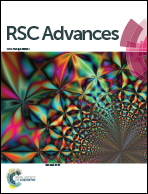Low dimensional cyano-bridged heterobimetallic M–FeIII (M = NiII, CuII) complexes constructed from Mer-[FeIII(qcq)(CN)3]− building blocks: syntheses, structures and magnetic properties†
Abstract
Four cyano-bridged heterobimetallic trinuclear complexes, {[Ni(en)2][Fe(qcq)(CN)3]2}·2H2O (1) [en = 1,2-ethylenediamine; qcq− = 8-(2-quinoline-2-carboxamido)quinoline anion], {[Ni(teta)][Fe(qcq)(CN)3]2}·2DMF·2H2O (2) (teta = 5,5,7,12,12,14-hexamethyl-1,4,8,11-tetraazacyclotetradecane, DMF = N,N-dimethylformamide), {[CuL1][Fe(qcq)(CN)3]2}·0.61H2O (3) (L1 = 3,10-dibutyl-1,3,5,8,10,12-hexaazacyclotetradecane) and {[CuL2][Fe(qcq)(CN)3]2}·4.75H2O (4) (L2 = 3,10-dipropyl-1,3,5,8,10,12-hexaazacyclotetradecane) have been synthesized and characterized both structurally and magnetically. The structural analyses reveal that 1–4 are all trinuclear centrosymmetric clusters, and the intercluster π–π interactions and hydrogen bonds extend 1–4 into high dimensional supermolecular networks. Magnetic investigation indicates that 1 and 2 exhibit intracluster ferromagnetic couplings accompanied by significant magnetic anisotropy. In contrast, 3 and 4 show unusual intracluster antiferromagnetic couplings, which could even be decoupled by a strong applied field.
![Graphical abstract: Low dimensional cyano-bridged heterobimetallic M–FeIII (M = NiII, CuII) complexes constructed from Mer-[FeIII(qcq)(CN)3]− building blocks: syntheses, structures and magnetic properties](/en/Image/Get?imageInfo.ImageType=GA&imageInfo.ImageIdentifier.ManuscriptID=C3RA45218B&imageInfo.ImageIdentifier.Year=2014)

 Please wait while we load your content...
Please wait while we load your content...